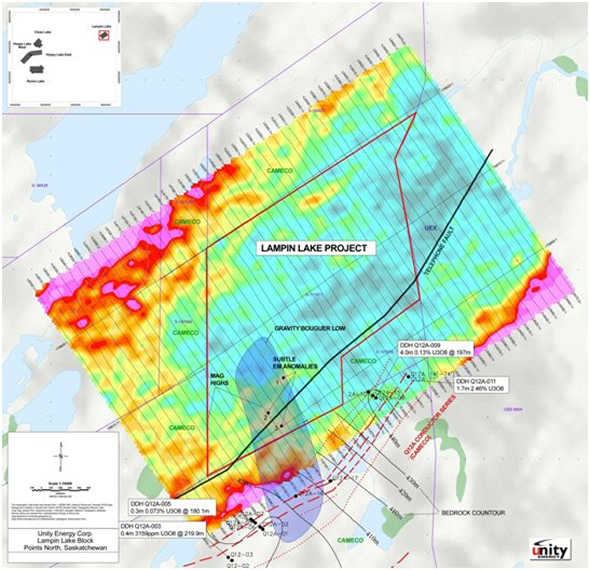Unity Energy Corp. has announced that it has completed evaluation of ground/airborne geophysics and historical drilling in and around the Lampin Lake Project and has identified a high value target, dubbed the Shamus Zone.
The Lampin Lake Project consists of a single 500ha disposition located on the eastern margin of the Athabasca basin. The Project lies in the Waterbury Lake district, ~16km southeast of Hathor's Roughrider discovery. It is bordered by claims held by UEX to the east (Hidden Bay Project) and Cameco on all other sides.

The Shamus Zone is characterized by a 500-750m wide northwest trending Bouguer Gravity low feature, beginning at Cameco's Q12A zone and ending several kilometers on the southwest corner of the Lampin Lake claim boundary. The gravity anomaly is roughly perpendicular to the Telephone Fault, may indicate a region of alteration, some of which has been subject to desilicification. The Telephone fault is interpreted as the primary control of this zone. Within gravity anomaly, the primary target is a series of subtle conductors coincident with magnetic lows, which appear to be related to extensions of Cameco's Q12A conductor series. The subtle conductors were identified through detailed interpretation of VTEM data, acquired by Unity in a survey completed in 2011.
Cameco's Q12A zone (some 500m to the south) shows areas of intermittent uranium mineralization at the unconformity and has been interpreted as the outlying edge of an alteration zone. Cameco and Asamara Oil have tested the Q12A zone with several ground geophysical surveys and extensive diamond drilling. Asmara Oil's diamond drilling of the Q12A grid intersected notable uranium mineralization as follows: Q12A-009 (4.0m of 0.13% U3O8 @ 197m), Q12A-003 (0.4m 3159ppm U3O8 @ 219.9m) and Q12A-005 (0.3m 0.073% U3O8 @ 180.1m), The most significant hole reported by Cameco was Q12A-011: 1.7m of 2.46% U3O8 at ~192m.
It is the Company's exploration hypothesis that the absence of strong conductors near or at the Telephone Fault may be a result of graphitic consumption or remobilization by alteration events. Several major uranium discoveries in the Athabasca Basin such as McArthur River, Key Lake and Millennium were primarily the result of drill-testing of strong alteration zones related to conductor features, not the drill testing of specific graphitic conductors. The Key Lake and Millennium deposits, which were initially missed in first-pass drilling, were discovered by step-out fenced holes drilled across alteration zones. Millennium was discovered by drilling "off conductor" and deeper into a basement alteration system. McArthur River was found by drilling along the strike-trend of a pronounced alteration system where conductors were largely absent. The Company is in the process of evaluating "next step" exploration phases. A ground survey (such as gravity, resistivity or 2D seismic) would likely precede diamond drilling.
Anita Algie BSc. Hon., President, commented, "Unity now has high value targets on both of its Waterbury Lake assets: Lampin Lake and Waterbury Lake. It is the Company's intention to explore and develop these highly prospective properties, with or without venture partners. In addition, the recent bidding war for Hathor by Cameco and Rio Tinto has reaffirmed in the minds of investors worldwide the viability of uranium as an exploration commodity. This may well be the black swan event that renews the uranium renaissance."